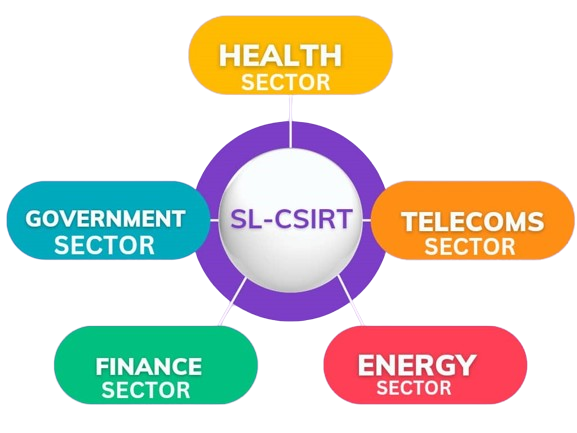
Overview:
SL-CSIRT is tasked with helping establish, coordinate, and support sectoral CSIRTs across critical sectors such as Government, Health, Finance, Energy, and Telecoms. This will involve a structured approach to ensure each sector is equipped to handle cybersecurity incidents effectively.
1.Setting Up Sectoral CSIRTs
Initial Assessment and Planning:
- Identify Critical Infrastructure: Work with sector stakeholders to identify and classify critical infrastructure components.
- Stakeholder Engagement: Engage key stakeholders in each sector to understand specific needs, challenges, and existing capabilities.
Framework Development:
- Standard Operating Procedures (SOPs): Develop SOPs tailored to each sector’s unique requirements, ensuring consistency with national guidelines.
- Policies and Protocols: Establish comprehensive policies and incident response protocols specific to each sector.
Resource Allocation:
- Funding and Tools: Secure funding and provide essential tools and technologies for sectoral CSIRTs.
- Training Programs: Develop and conduct training programs to build sector-specific cybersecurity skills and knowledge.
2. Coordinating Sectoral CSIRTs
Centralized Coordination Mechanism:
- Coordination Hub: Establish a centralized coordination hub within SL-CSIRT to facilitate communication and coordination among sectoral CSIRTs.
- Incident Reporting System: Implement a robust incident reporting system that enables seamless information sharing and collaboration.
Regular Meetings and Workshops:
- Sectoral Meetings: Hold regular meetings with sectoral CSIRTs to discuss ongoing issues, share insights, and coordinate responses.
- Workshops and Drills: Organize joint workshops and cybersecurity drills to simulate incidents and improve coordinated responses.
Information Sharing:
- Threat Intelligence Sharing: Develop a secure platform for sharing threat intelligence, best practices, and lessons learned among sectoral CSIRTs.
- Advisories and Alerts: Issue timely advisories and alerts on emerging threats and vulnerabilities relevant to each sector
3. Supporting Sectoral CSIRTs
Technical and Operational Support:
- Incident Response Support: Provide on-demand support for complex or large-scale incidents that require additional expertise.
- Cyber security Tools: Supply advanced cyber security tools and technologies to enhance detection, response, and recovery capabilities.
Continuous Improvement:
- Audits and Assessments: Conduct regular audits and assessments to identify gaps and areas for improvement in sectoral CSIRTs.
- Feedback Mechanism: Establish a feedback mechanism to gather input from sectoral CSIRTs and continuously refine processes and support structures.
Capacity Building:
- Ongoing Training: Offer continuous training and professional development opportunities to keep sectoral CSIRT personnel updated on the latest trends and techniques.
- Knowledge Resources: Develop and maintain a repository of knowledge resources, including guidelines, best practices, and case studies.
4. General Coordination and Support
National Strategy Alignment:
- Policy Alignment: Ensure that sectoral CSIRT policies and procedures align with national cybersecurity strategies and regulations.
- Unified Response Framework: Create a unified incident response framework that allows for coordinated action across all sectors during national-level incidents.
Public Awareness and Outreach:
- Awareness Campaigns: Conduct public awareness campaigns to educate the general public and organizations about the importance of cybersecurity and the role of sectoral CSIRTs.
- Stakeholder Collaboration: Foster collaboration with industry associations, academic institutions, and international partners to strengthen overall cybersecurity resilience.

